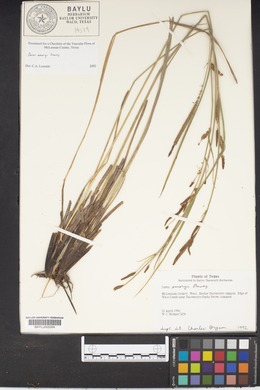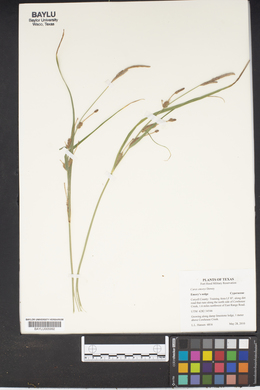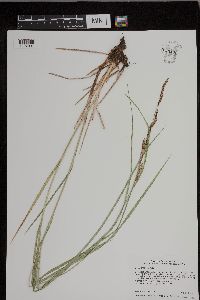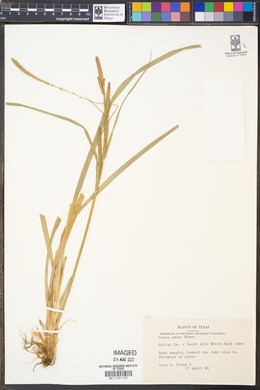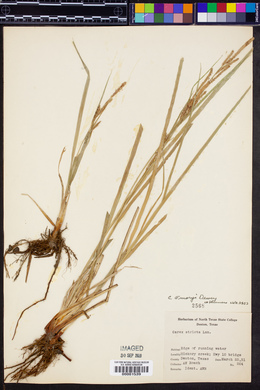Carex emoryi
|
|
|
|
Family: Cyperaceae
Emory's Sedge
[Carex millegrana, moreCarex stricta var. elongata (Boeckeler) Gleason, Carex stricta var. emoryi (Dewey) L.H.Bailey] |
Plants not cespitose. Culms acutely or obtusely angled, 30-115 cm, scabrous. Leaves: basal sheaths red-brown; sheaths of proximal leaves glabrous, fronts lacking spots and veins, apex convex, prolonged; blades 3-6 mm wide. Inflorescences: proximal bract equal to inflorescence, 3-5 mm wide. Spikes erect; proximal 3-5 spikes pistillate, 2.5-10 cm × 3-5 mm, base attenuate; terminal 2-3 spikes staminate. Pistillate scales pale or red-brown, equaling perigynia, apex acute, awnless. Perigynia ascending, green, spots absent, 3-5-veined on each face, somewhat flattened, loosely enclosing achenes, ellipsoid, 1.7-3.2 × 1-2.1 mm, dull, apex rounded or obtuse, papillose; beak 0.1-0.3 mm. Achenes not constricted, dull. 2n = 72. Fruiting May-Jun. Stream banks, ditches, seeps; 0-1200 m; Man., Ont.; Ark., Colo., Conn., Del., D.C., Ill., Ind., Iowa, Kans., Md., Mich., Minn., Mo., Nebr., N.J., N.Mex., N.Y., N.Dak., Ohio, Okla., Pa., S.Dak., Tex., Va., W.Va., Wis., Wyo.; Mexico (Chihuahua, Coahuila). Carex emoryi resembles C. aquatilis in size and habit, and has similar sheaths and spike dimensions. It is distinguished by the finely veined perigynia, the prolonged convex sheath apex and truncate ligule, and the hypostomic leaves. Most specimens identified as C. aquatilis var. altior are C. aquatilis; the type of C. aquatilis var. altior is an immature specimen of C. emoryi. Although previously thought to be related to C. stricta, the differences in sheath characters and higher chromosome number suggest that C. emoryi is not a member of the C. stricta subgroup.
VPAP (Rink and Licher 2015), Allred and Ivey 2012 General: Perennial, grass-like herbs, 12-120 cm tall, with loose clusters of several stems connected by extensive stout rhizomes, 2-3 mm thick; stems solid (not hollow) and obtusely triangular, shorter or longer than the leaves, and scabrous. Vegetative: Leaf bases form sheaths around the stems, with the blades diverging from the stem spirally in 3 ranks; blades linear and grasslike, 2-6 mm wide; sheaths straw-colored to red-brown, the sheath fronts whitish hyaline (papery) and thin, veinless, and rarely Inflorescence: Inflorescence an elongate terminal raceme, 7-21 cm long, of several compact spikes; the 2-3 spikes closest to the branch tips consist of only male (staminate) flowers, and 3-5 spikes below that have mostly female (pistillate) flowers, often with a section of male flowers at the tips; female spikes are 2-6 cm long, sessile or rarely on peduncles up to 1 cm long; the lowest female spike is subtended by a long bract, 2-5 mm wide, which resembles a leaf blade and can be shorter or longer than the entire inflorescence. The flowers are tiny and lack petals and sepals; instead each flower is subtended by a scale; male flowers contain 3 stamens which may be visible emerging from behind the scale, or on older material the stamens may be absent and only a scale remains of each male flower; female flowers contain a structure called a perigynium, which encompasses the ovary (and later encompasses the seed), and terminates in a beak with the style and 2 stigmas emerging from the top; scales on female flowers are oblong, narrower and often shorter than the perigynia, light brown or red-brown with a broad pale green midvein, and blunt to acute at the tip; perigynia are 2-3 mm long and 1-2 mm wide, ovate to elliiptic, somewhat flattened and loosely enclosing the seed, lightly 3-5 veined on each face, green to straw-colored, papillose (covered with tiny bumps), and topped with a tiny beak; seeds one per female flower, lenticular (lens or lentil-shaped), 1–2 mm long, dull. Ecology: Found on river banks and in marshes, around 3,000 ft (914 m); flowers Apr–May. Distribution: Manitoba and Ontario, CAN; west to CO and AZ, east to NY, and south to TX and MEX.. Notes: Carex emoryi is most likely to be confused with C. aquatilis which it resembles in size and growth form, along with having similar sheaths and spike dimensions. It can be distinguished by its finely nerved perigynia and its lighter brown pistillate scales with usually a broad pale midvein. C. emoryi occurs at lower elevations, while C. aquatilis occurs in high elevation wetlands (above 7,000 ft). Ethnobotany: Unknown Etymology: Carex comes from the Greek word kerein, to cut, alluding to the sharp-edged leaves of some species; emoryi honors William Hemsley Emory (1811–1887), a US Army officer who led expeditions to conduct boundary surveys along the US-Mexico border. Editor: AHazelton 2017 Rhizomatous, with both short and long rhizomes, the slender stems arising laterally, scabrous on the angles, 4-12 dm; lowest lvs reduced to reddish-brown, bladeless sheaths; main lvs 3.5-6(-8) mm wide, the sheaths glabrous, reddish dorsally, with a tawny, generally convex mouth; lowest bract lf-like, about equaling the infl, the others reduced; staminate spikes (1)2(3), 1.5-5 cm; pistillate spikes 3-5, short-pedunculate or sessile, erect, 2-10 cm, slender, tapering at the base, the uppermost with some distal staminate fls; pistillate scales with a broad green or tawny midstrip and a submarginal tawny to reddish-brown band, generally narrower and shorter than the perigynia; perigynia 1.7-3.2 mm, green becoming stramineous, not dotted, flattened and planoconvex, usually several-nerved on each side, short-beaked; achene lenticular, closely enveloped by the perigynium; 2n=72. Streambanks and roadside ditches; s. N.Y. to N.D. and Man., s. to Va., n. Ark., and Tex. (C. stricta var. e.) Gleason, Henry A. & Cronquist, Arthur J. 1991. Manual of vascular plants of northeastern United States and adjacent Canada. lxxv + 910 pp. ©The New York Botanical Garden. All rights reserved. Used by permission. From Flora of Indiana (1940) by Charles C. Deam Frequent along banks of creeks and in swamps, sloughs, and swales in woods. Not known from the unglaciated area. ...... Indiana Coefficient of Conservatism: C =7 Wetland Indicator Status: OBL |
|
|
|




















